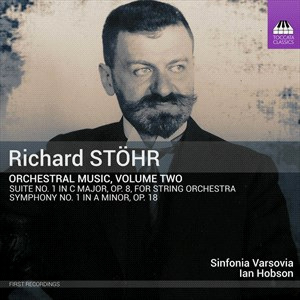

Suite No. 1 in C Major, Op. 8, for string orchestra Symphony No. 1 in A Minor, Op. 18
Austro-American composer, author and teacher Richard Franz Stöhr (1874-1967), of Hungarian descent and born the same year as Arnold Schoenberg, was a prolific and highly respected composer during his lifetime. He wrote seven symphonies, multiple orchestral works, two operas, choral and vocal pieces, and many chamber music works. In 1938 his post at the Vienna Conservatory was terminated because of his Jewish heritage. He moved to the United States and became a member of the faculty at the Curtis Institute of Music in Philadelphia. Many of his most notable students include Rudolf Serkin, Herbert von Karajan, Leonard Bernstein and Samuel Barber to name but a few. Were it not for the recent efforts by Toccata Classics to unearth and record some of his chamber and orchestral works, his music would have fallen prey to the jaws of oblivion.
In Brucknerian fashion, the first movement of his Symphony No. 1 in A Minor, Op. 18 from 1909, opens and closes with bold and energetic statements from the horns which establish the thematic structure of the whole symphony. It is scored for a large orchestra which even includes a pipe organ within the third Andante religioso movement. Critics of the day described it as "formally accomplished, but without deep spiritual content" {Booklet Notes}. In hindsight, were those critics alive today, they would be of a different opinion now when comparing this symphony to many other 20th century symphonic works. Aside from the harmonically rich and solemnly somber third movement which very well integrates the sound of a pipe organ within its orchestral fabric, the symphony on the whole is of a generally upbeat character, somehow at odds with the somewhat darker symphonic output of other composers of the day. I would even go so far as to say that its final movement compares well, in disposition, to some of the early symphonies by Gustav Mahler.
The same can be said about the Suite No. 1 in C Major, Op. 8 where the outer movements driven by graceful rhythmical propulsion, are counterbalanced with an expressively lyrical inner slow movement. It compares well with famous works for string orchestra by English composers like Holst, Delius, Bax, etc... These are all first recordings, all worth the attention of classical music enthusiasts eager to hear hitherto unavailable material.
Jean-Yves Duperron - July 2023 Symphony No. 1